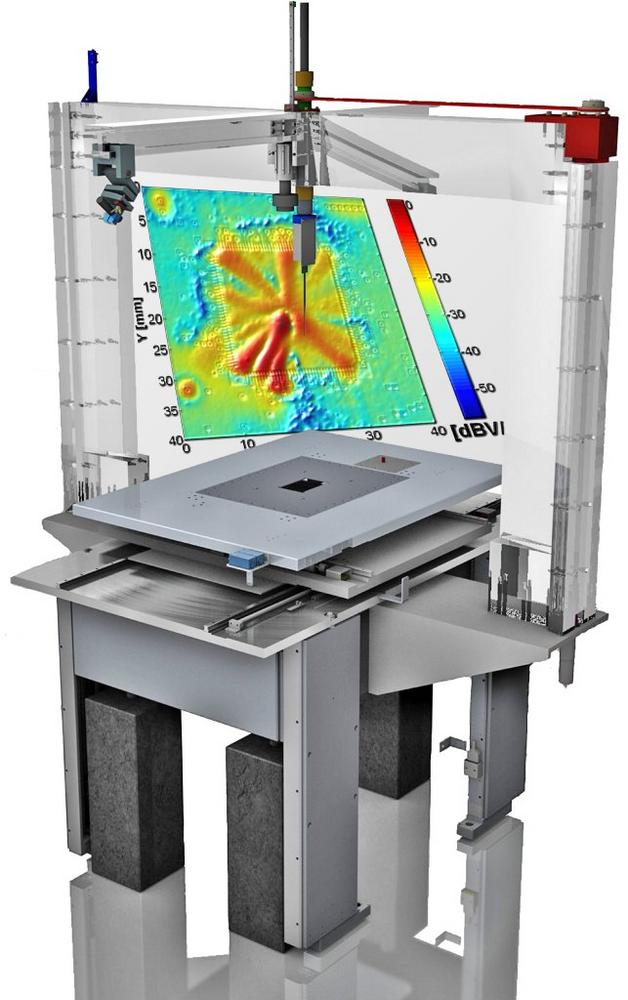By use of near-field measurements, electric and magnetic fields can be locally resolved and are depicted a few millimeter to centimeter above the device under test (DUT). Such results then can be utilized for EMC analysis and search for error causes. Adapted near-field probes are used for each field component. With a robot system, the test object is moved in a predetermined grid in the reception area of the probe and a spatially scanned field image of the object is created. One such system for electromagnetic near-field measurements is the NFS3000. It was developed at the Fraunhofer Institute for Electronic Nano Systems in Paderborn. One of its uniqueness’s is the very precise positioning system with an accuracy of one micron, making it capable to visualize the local field distribution of even integrated circuits. On the other hand, the measurement system has a maximum movement range of 80 cm x 50 cm x 50 cm (xyz) and hence can electromagnetically characterize whole systems. Comparable near-field scanners have either a small step size or a large measuring range. With a phase-related measurement of magnetic and electric fields up to 2.7 GHz and a pure measurement of amplitudes up to 6 GHz, systems up until the Wi-Fi and Bluetooth spectrum can be characterized. Currently, the extension of the measurement system up to 80 GHz is planned to be equipped for future 5G and radar applications.
The measurement results, which originate with the NFS3000, can then be post processed and utilized in different ways. The simplest purpose is the analysis of the fields above the DUT, to detect and locate unwanted radiations. For instance, the developer accidentally could have implemented resonant circuits and loops into the layout. Certain trace geometries can lead to radiation hotspots and couplings into other parts occur, or components and circuits malfunction and radiate in unexpected frequency ranges. Furthermore, the results can be post processed with a near-field to far-field transformation, to predict EMC measurements, as they are done by a certification center. For that reason, the near-field data are imported into a simulation tool and get extrapolated into the far-field. Thus, the directivity of antennas can also be determined. Thirdly, the measurement results can be imported into an electromagnetic simulation tool as source to perform further analysis. These include effects of field distribution on enclosures, the effectiveness of shielding methods, or coupling to other nearby systems and components.
In all its functions and with its connection to simulation tools, the NFS3000 is an ideal measuring instrument for performing EMC analysis and interference suppression of components during development. The range extends from the simple measurement of devices as a service for developers to the combination of measurements with simulations in research and industrial projects. In the early phases of hardware development, for example, parameter studies can be carried out and accompanied by measurements and simulations in order to obtain systems with optimum properties.
The Fraunhofer-Gesellschaft is the leading organization for applied research in Europe. Its research activities are conducted by 72 institutes and research units at locations throughout Germany. The Fraunhofer-Gesellschaft employs a staff of more than 26,600, who work with an annual research budget totaling 2.6 billion euros. Of this sum, 2.2 billion euros is generated through contract research. Around 70 percent of the Fraunhofer-Gesellschaft’s contract research revenue is derived from contracts with industry and from publicly financed research projects. International collaborations with excellent research partners and innovative companies around the world ensure direct access to regions of the greatest importance to present and future scientific progress and economic development.
Fraunhofer-Institut für Elektronische Nanosysteme ENAS
Technologie-Campus 3
09126 Chemnitz
Telefon: +49 (89) 1205-0
Telefax: +49 (89) 120575-31
http://www.enas.fraunhofer.de/
Marketing / PR
Telefon: +49 (371) 45001-204
Fax: +49 (371) 45001-304
E-Mail: andrea.messig-wetzel@enas.fraunhofer.de
Telefon: +49 (5251) 6056-36
E-Mail: dominik.schroeder@enas-pb.fraunhofer.de
![]()
